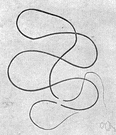filum
Also found in: Thesaurus, Medical, Encyclopedia, Wikipedia.
fi·lum
(fī′ləm)n. pl. fi·la (-lə)
A threadlike anatomical structure; a filament.
American Heritage® Dictionary of the English Language, Fifth Edition. Copyright © 2016 by Houghton Mifflin Harcourt Publishing Company. Published by Houghton Mifflin Harcourt Publishing Company. All rights reserved.
filum
(ˈfaɪləm)n, pl -la (-lə)
(Anatomy) anatomy any threadlike structure or part
[Latin: thread, cord, fibre]
Collins English Dictionary – Complete and Unabridged, 12th Edition 2014 © HarperCollins Publishers 1991, 1994, 1998, 2000, 2003, 2006, 2007, 2009, 2011, 2014
fi•lum
(ˈfaɪ ləm)n., pl. -la (-lə).
a threadlike structure; filament.
[1855–60; < Latin: a thread, filament, fiber]
Random House Kernerman Webster's College Dictionary, © 2010 K Dictionaries Ltd. Copyright 2005, 1997, 1991 by Random House, Inc. All rights reserved.
ThesaurusAntonymsRelated WordsSynonymsLegend:
Switch to new thesaurus
| Noun | 1. |  filum - a threadlike structure (as a chainlike series of cells) filum - a threadlike structure (as a chainlike series of cells)anatomical structure, bodily structure, body structure, complex body part, structure - a particular complex anatomical part of a living thing; "he has good bone structure" |
Based on WordNet 3.0, Farlex clipart collection. © 2003-2012 Princeton University, Farlex Inc.